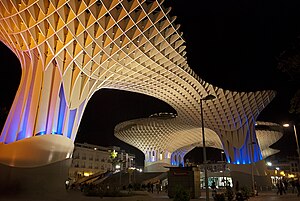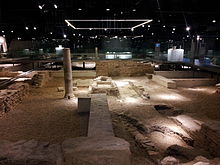Metropol Parasol
Coordinates: 37°23′35.71″N 5°59′30.77″W / 37.3932528°N 5.9918806°W
This article may be expanded with text translated from the corresponding article in Spanish. (March 2012) Click [show] for important translation instructions.
|
| Setas de Sevilla | |
|---|---|
 | |
 | |
| General information | |
| Location | Seville, Spain |
| Construction started | 2005 |
| Completed | 2011 |
| Management | Sacyr |
| Design and construction | |
| Architect | Jürgen Mayer H. |
| Main contractor | Sacyr |
Setas de Sevilla ("Mushrooms of Seville") or Las Setas ("The Mushrooms"), initially titled Metropol Parasol,[a] is a wooden structure located at La Encarnación square in the old quarter of Seville, Spain. It was designed by the German architect Jürgen Mayer and completed in April 2011.[4] It has dimensions of 150 by 70 metres (490 by 230 ft) and an approximate height of 26 metres (85 ft)[5] and claims to be the largest wooden structure in the world.[6] Its appearance, location, delays and cost overruns in construction resulted in much public controversy.
Description[]

The structure consists of six parasols in the form of giant mushrooms, whose design is inspired by the vaults of the Cathedral of Seville and the ficus trees in the nearby Plaza de Cristo de Burgos. The Setas are organized in four levels. The underground level (Level 0) houses the Antiquarium, where Roman and Moorish remains discovered on site are displayed in a museum.[6] Level 1 (street level) is the Central Market. The roof of Level 1 is the surface of the open-air public plaza, shaded by the wooden parasols above and designed for public events. Levels 2 and 3 are the two stages of the panoramic terraces (including a restaurant), offering a view of the city centre.[7]

History[]
From the 19th century a market was located in the plaza, housed in a dedicated building. The building was partially demolished in 1948 in accordance with plans for urban renewal. The market itself remained, however, until 1973, when the rest of the dilapidated building was finally demolished. The land remained dormant until 1990, when the city decided to construct underground parking with space for a market on top. However, in the midst of construction, ruins dating to the Roman and Al-Andalus eras were discovered, and construction was frozen after an expenditure of 14 million euros. In 2004, the city decided to attempt to develop the area again, and opened an international competition to solicit bids.
Construction[]


Construction began on June 26, 2005, with an estimated cost of 50 million euros and a projected completion date in June 2007. However, unknown to the public, the project soon faced difficulties. By May 2007 engineering firm Arup informed the municipal authorities that the structure was technically unfeasible as designed, given that a number of structural assumptions had not been tested and the design appeared to violate the limitations of known materials. The wood used was birch, imported from Finland, because of its straight qualities.[8] Much time was spent developing feasible alternative plans to buttress the structure, which themselves proved impractical because of the added weight.[8] A feasible design using glue as reinforcement was finally settled on only at the beginning of 2009.[8] By some estimates, due to delays, the total cost of the structure approached 100 million euros.[9]
Notes[]
- ^ "Setas de Sevilla" has been the project's official name since opening.[1] The name "Setas" started as a nickname amongst locals.[2] The municipality switched to that name after finding out that the project's architect had registered the rights to the name "Metropol Parasol" and would charge for its use.[3]
The name "Las Setas de la Encarnación" is also used.[3]
References[]
- ^ "Historia" (in Spanish). Setas de Sevilla. Archived from the original on 2021-05-09.
- ^ "History and Construction: 2011". Setas de Sevilla.
{{cite web}}: CS1 maint: url-status (link) - ^ a b "Las Setas de la Encarnación cumplen diez años mientras Sevilla sigue pagando su factura". sevilla (in Spanish). 2021-03-27. Retrieved 2021-12-21.
- ^ Costas Voyatzis (2011-04-28). "Metropol Parasol // The World's Largest Wooden Structure". Yatzer. Retrieved 2012-01-19.
- ^ "Leyendas de Sevilla: Metropol Parasol y Antiquarium". Leyendasdesevilla.blogspot.com. 2011-07-19. Retrieved 2012-01-19.
- ^ a b Brendan Sainsbury (2012-01-06). "Travel - Seville goes green". BBC. Retrieved 2012-01-19.
- ^ Rowan Moore (2011-03-27). "Metropol Parasol, Seville by Jürgen Mayer H – review | Art and design | The Observer". London: Guardian. Retrieved 2012-01-19.
- ^ a b c Marmol, Carlos. "Un proyecto imposible" diariodesevilla.es February 2, 2010. Accessed September 30, 2012
- ^ Yanez, A. Estrella. Las "setas" de Encarnacion costaron ahora a cada Sevillano 143 euros" ABC.es January 30, 2010. Accessed September 30, 2012.
| Wikimedia Commons has media related to Metropol Parasol. |
- Buildings and structures in Seville
- Tourist attractions in Seville
- Wooden buildings and structures in Spain

